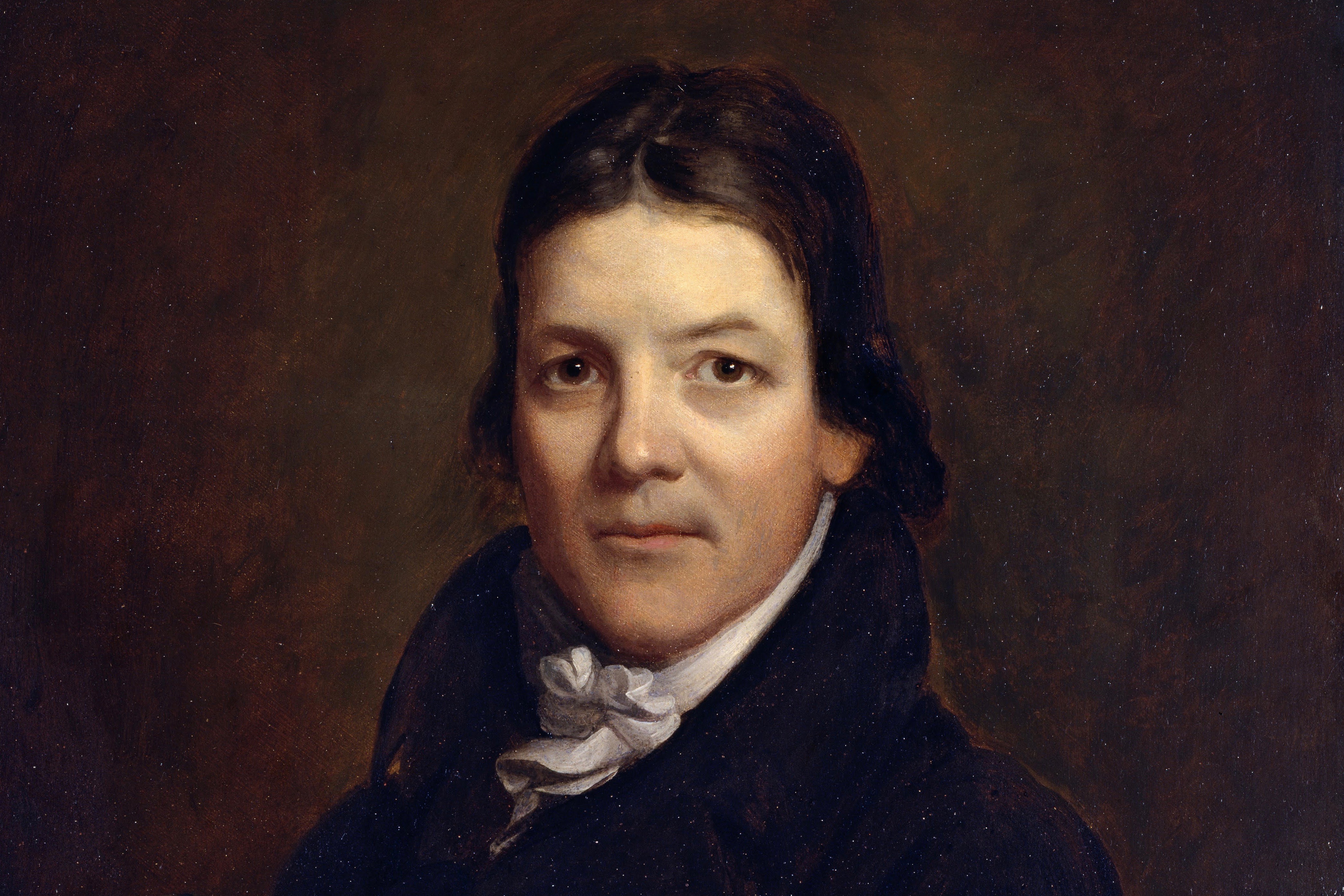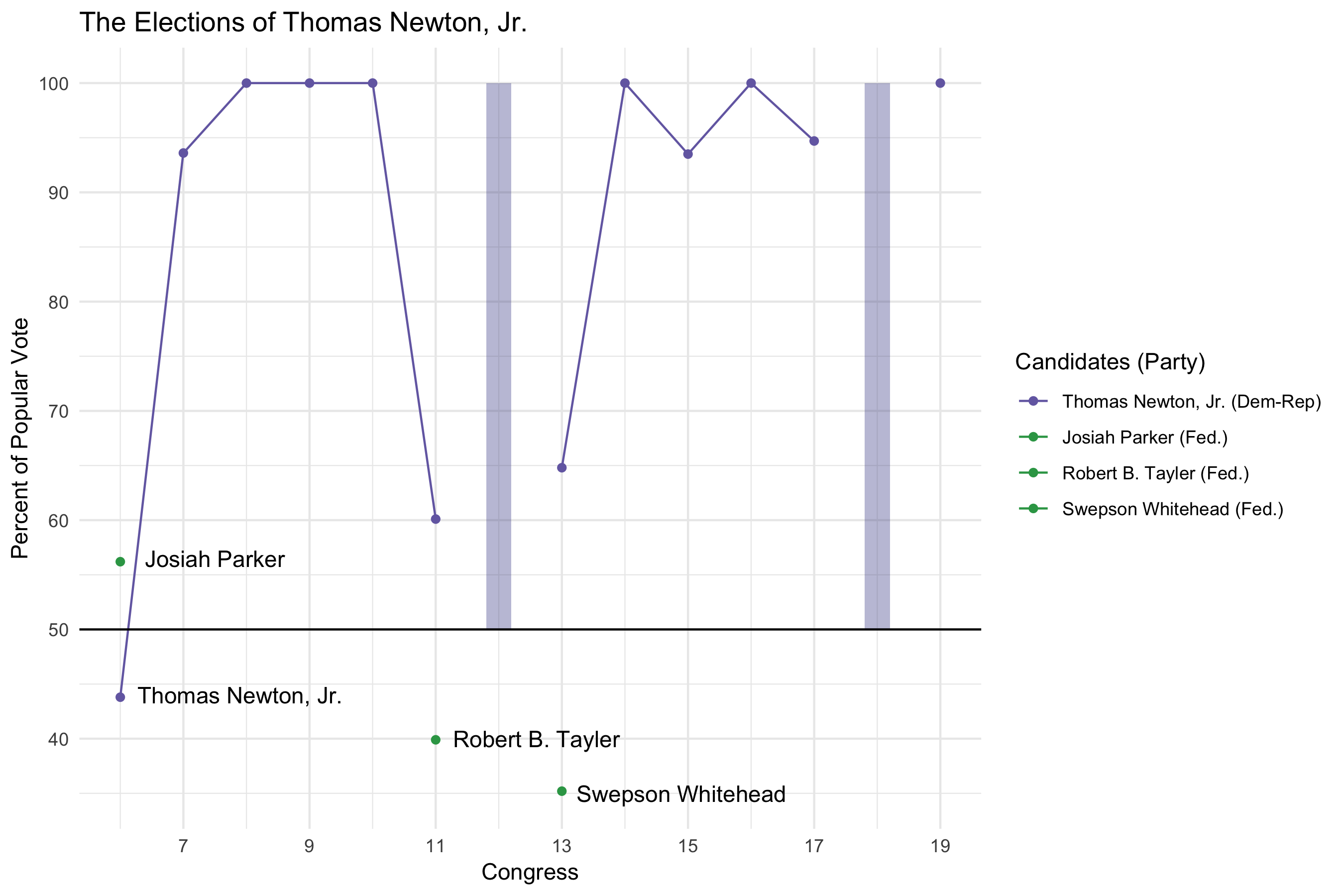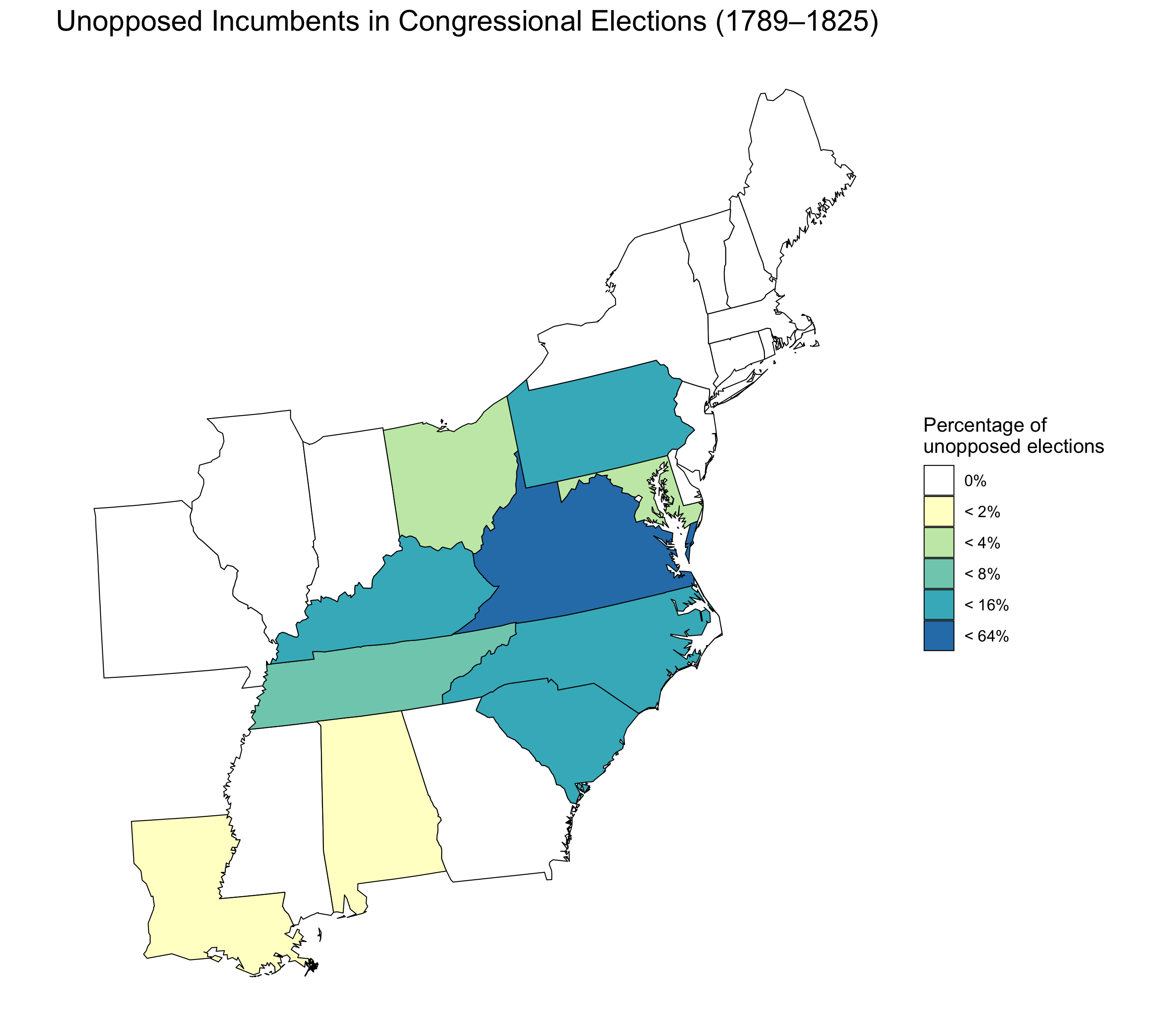Congressional Incumbency in the Early Republic

The issue of congressional turnover provides important insights into the nature of political representation in Congress. Turnover measures the number of representatives who fail to return to the next session of Congress, either through a failure to be reelected or voluntary retirement from office. Turnover has changed dramatically over time. In recent Congresses, no more than ten percent of the membership has left, or been replaced, during a typical election cycle. In one recent Congress—the 115th, elected in 2016—only three percent of the sitting members of Congress failed to be reelected. (In other words, 380 of the 393 members who sought reelection were successful.) In the early Congresses, however, thirty percent or more of the membership typically failed to return to their seat in the next Congress.
Another way to think about turnover is through the concept of incumbency. Incumbency measures the percentage of members who remain in office rather than the proportion of those who rotate out of office. Incumbency can take two different forms: party incumbency and legislator incumbency. The primary difference is between what is measured. Whereas “legislator” incumbency focuses on whether or not a particular individual remains in office, “party” incumbency focuses on which political party remains in office, even if specific representatives themselves are different. This approach has the advantage of highlighting the persistence of particular parties in various geographic regions. The Mapping Early American Elections (MEAE) project provides a lens through which to explore reelection and incumbency during the nation’s formative years.
In the early republic, the political scene was quite different from that of today. State legislators elected the Senate. Either state legislators or the voters in a state elected the presidential electors who, in turn, elected the president. The House of Representatives was the only part of the federal government in which officials were directly elected by the people. The first Congress in 1789 met in New York City; the Second Congress, in Philadelphia. Then, in the 1801, the federal government moved from Philadelphia to the newly built capital in Washington D.C. The new federal city did not offer the comfortable services, amenities, and cultural life that Philadelphia and New York City had provided. Even more important, Congress met far from where most Americans lived. Representatives had to spend long periods of time away from their families and homes while Congress was in session. This isolation put a strain on marriages, family relationships, and personal finances, contributing to a high rate of voluntary retirements. In fact, about one-third of those who did not return to the next Congress had done so not because they had failed to be reelected, but because they chose to leave their seat voluntarily. Serving in Congress thus often imposed extreme burdens on the members of Congress as well as their families.
| Candidate | 1 | 2 | 3 | 4 | 5 | 6 | 7 | 8 | 9 | 10 | 11 | 12 | 13 | 14 | 15 | 16 | 17 | 18 | 19 |
|---|---|---|---|---|---|---|---|---|---|---|---|---|---|---|---|---|---|---|---|
| Caesar A. Rodney | ✔ | ✔ | |||||||||||||||||
| Henry M. Ridgely | ✔ | ✔ | |||||||||||||||||
| James A. Bayard | ✔ | ✔ | ✔ | ✔ | |||||||||||||||
| James M. Broom | ✔ | ||||||||||||||||||
| John Patten | ✔ | ✔ | |||||||||||||||||
| John Vining | ✔ | ✔ | |||||||||||||||||
| Louis McLane | ✔ | ✔ | ✔ | ✔ | ✔ | ||||||||||||||
| Nicholas Van Dyke | ✔ | ||||||||||||||||||
| Thomas Clayton | ✔ | ||||||||||||||||||
| Thomas Cooper | ✔ | ✔ | |||||||||||||||||
| Willard Hall | ✔ | ✔ |
The framers of the Constitution did not include a provision establishing a mandatory rotation in office for members of Congress. What may appear to be a critical oversight was more accurately a point of debate. James Madison, George Mason, and Thomas Jefferson supported such a provision and many state constitutions included mandatory rotation of office for their governors and legislatures. However, those who opposed the provision thought that the weaknesses of the Articles of Confederation highlighted the need for a stronger federal government, one in which those elected did so on their merit and reputation. In the end, instead of dictating how many terms members of Congress could serve, they left it to the voters to decide who should be elected or reelected. The framers did not, however, anticipate the emergence of political parties.
The emergence of political parties meant that voters could elect members to Congress from the same political party (who presumably shared similar basic party ideology), while electing different individuals to serve in that position. The MEAE project enables us to visually track party incumbency, or party persistence, over time. For example, beginning in the 3rd Congress, Maryland’s 1st, 3rd, and 8th districts (representing the southern and western part of the state) continued to reelect Federalists until the 18th Congress. During this time span, although sixteen different candidates were elected, all were members of the Federalist party in some form. Similarly, Maryland’s 5th district, encompassing the city of Baltimore and the surrounding area, remained solidly Democratic-Republican. Maryland’s remaining districts oscillated between Federalist and Democratic-Republican. This persistence of these patterns of incumbency highlight the regional differences within the state as well as demonstrate the differences between an urban center and more rural counties.
While career or professional politicians did not exist in the early years of the country, there were a number of individuals who maintained a sustained tenure in Congress. Thomas Newton Jr. of Virginia served as a Representative from the 7th–22nd Congresses. (Note, however, that MEAE has election data only for the 7th–19th Congresses.) Representing the area surrounding Norfolk, Newton remained a popular candidate, winning the majority of his elections in landslides. Even more surprising is Newton’s support of John Quincy Adams in the hotly contested 1824 Presidential election. Newton represented one of only seven Adams-Clay supporters in his entire state. Another Virginia representative who had a long career was John Randolph who served in twelve Congresses from 1800 to 1827. Randolph is of particular interest because his party allegiance changes over the course of his political life. Initially a Democratic-Republican, Randolph split from the party and joined coalition of politicians known as Tertium Quids for Congresses 9–12. Twice he ran unopposed, even after becoming a Tertium Quid. Newton and Randolph represent a group of Virginia incumbents who continued to be reelected and maintained their voice and influence within Congress over long periods of time.

Unopposed reelections represent an intriguing subsection of incumbency in the early republic. Of all the congressional elections in the MEAE dataset, 322 or twelve percent are unopposed elections. 250 of those elections represent unopposed incumbents. William A. Burwell of Virginia participated in the most unopposed elections, winning a seat in the 10th through the 16th Congresses. Burwell was hardly the exception for Virginia. Nine of the top fifteen representatives with the most unopposed elections were from the state of Virginia accounting for fifty-nine percent of the total 75 elections among them. Virginia accounted for the most unopposed elections and the majority of unopposed elections took place in the South (Virginia, Kentucky, South Carolina, and North Carolina). The prevalence of unopposed incumbents in Virginia illustrates both the district-wide support for the individual, as well as the political clout such a person wielded. These elections also reflect the persistence of an older form of deferential politics that was quickly becoming obsolete in a democratizing nation.

Both in the early republic and today, high turnover can result from a number of causes. Voters may turn their representatives out of office at a high rate because of dissatisfaction with their member’s views or character, or from a desire to have a fresh face in Congress. Alternatively, high turnover may result from representatives themselves refusing to seek reelection, either because they fear losing their seat, desire to remain at home with their families, or choose to seek other political or economic opportunities. Turnover can be a healthy development, by bringing new members to Congress who revitalize the institution. Turnover can also be disadvantageous because it removes experienced members from Congress, thus depriving the institution of their knowledge and expertise. Despite the lack of formal restriction on congressional terms, high turnover in the early congresses produced a kind of de facto rotation in office during the new republic’s first decades. At the same time, incumbency rates tell a slightly different story. During the first decades of the new nation, incumbency rates reveal how and when different regions of the country, and different areas within the states, chose to support one party or the other. The maps in the MEAE project reveal the shifting fates of the Federalists and Democratic-Republicans as well as emergence at different times of splinter factions and new political parties. These maps then, illustrate the story of the country’s complex and uneven path toward a two-party political system.


